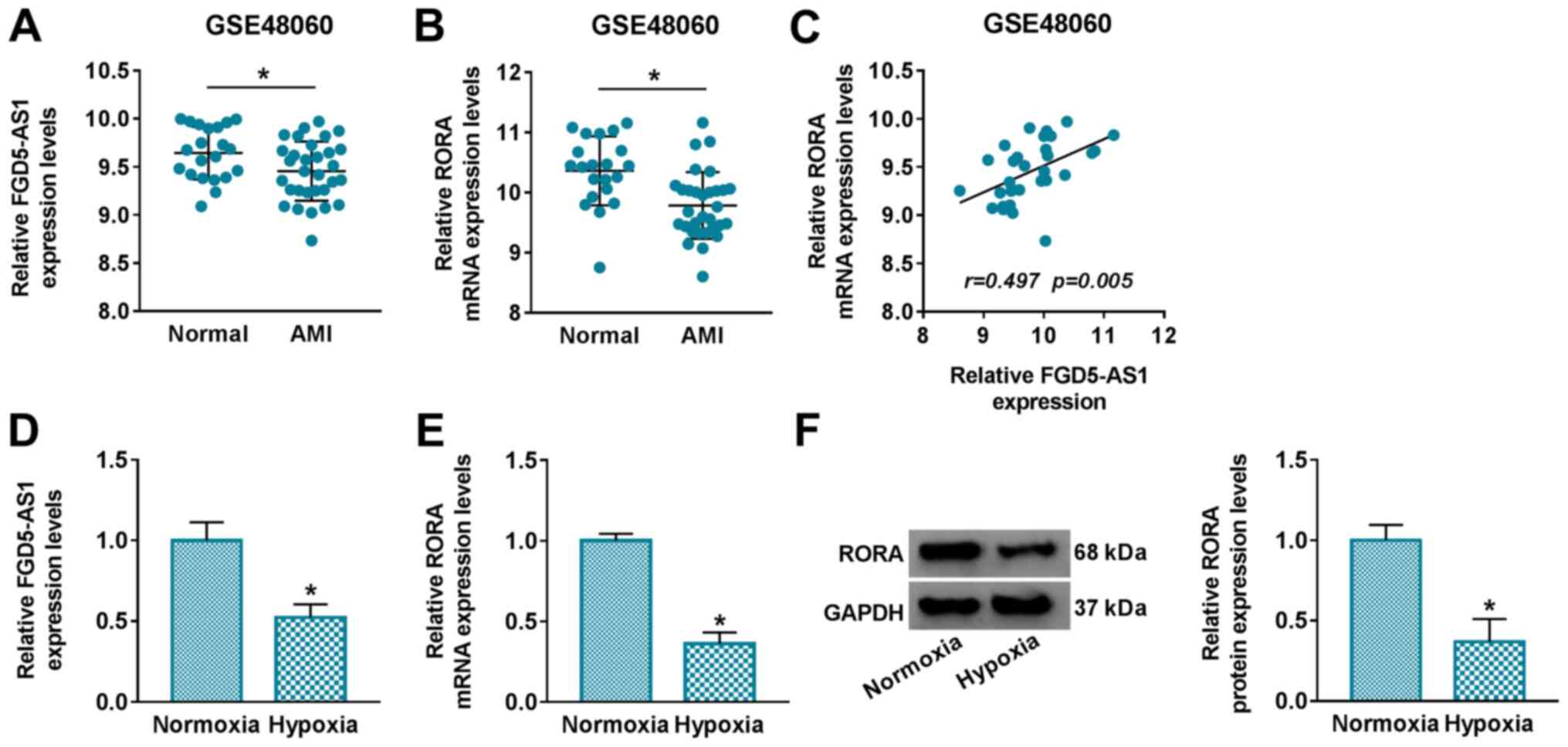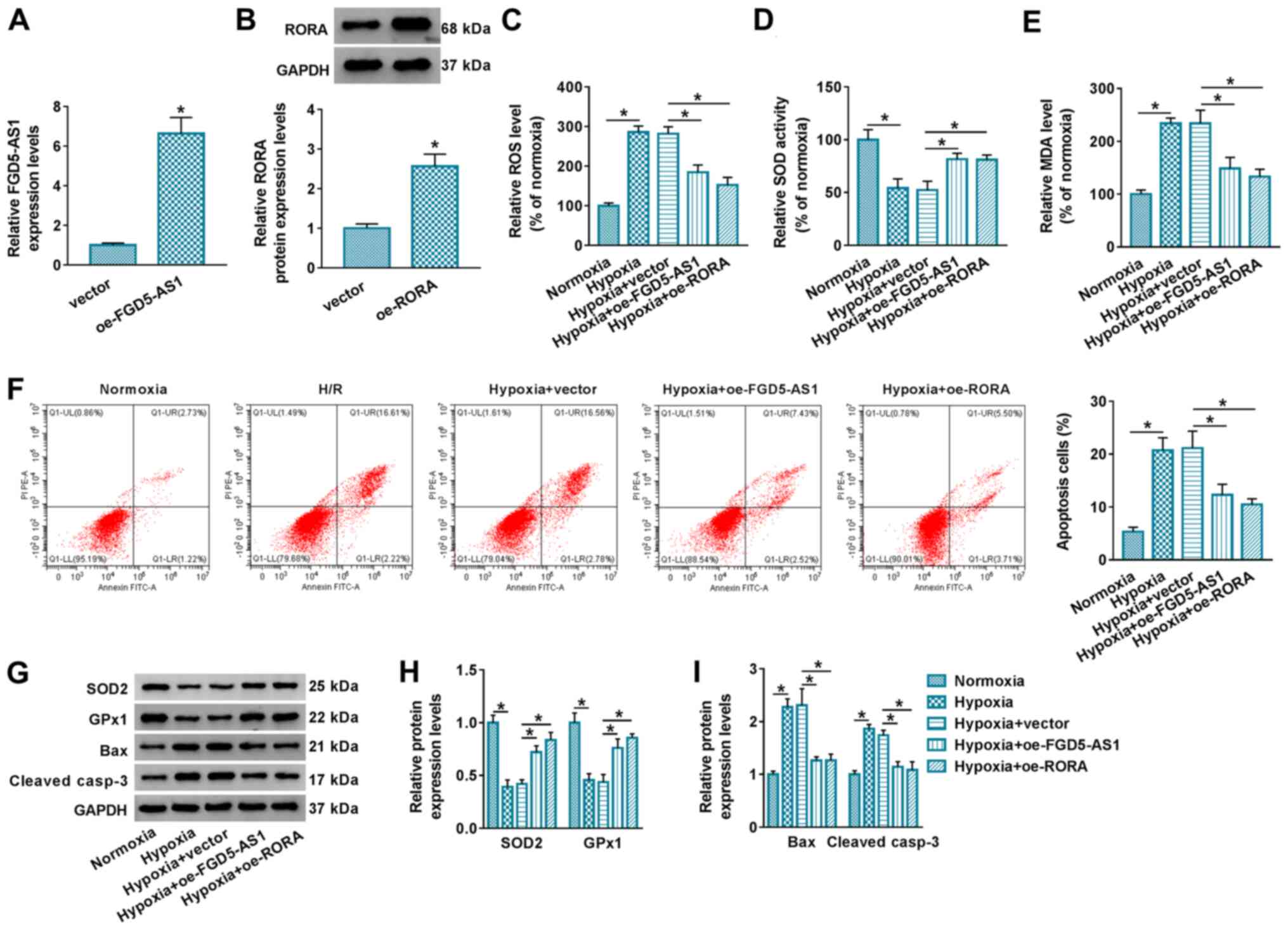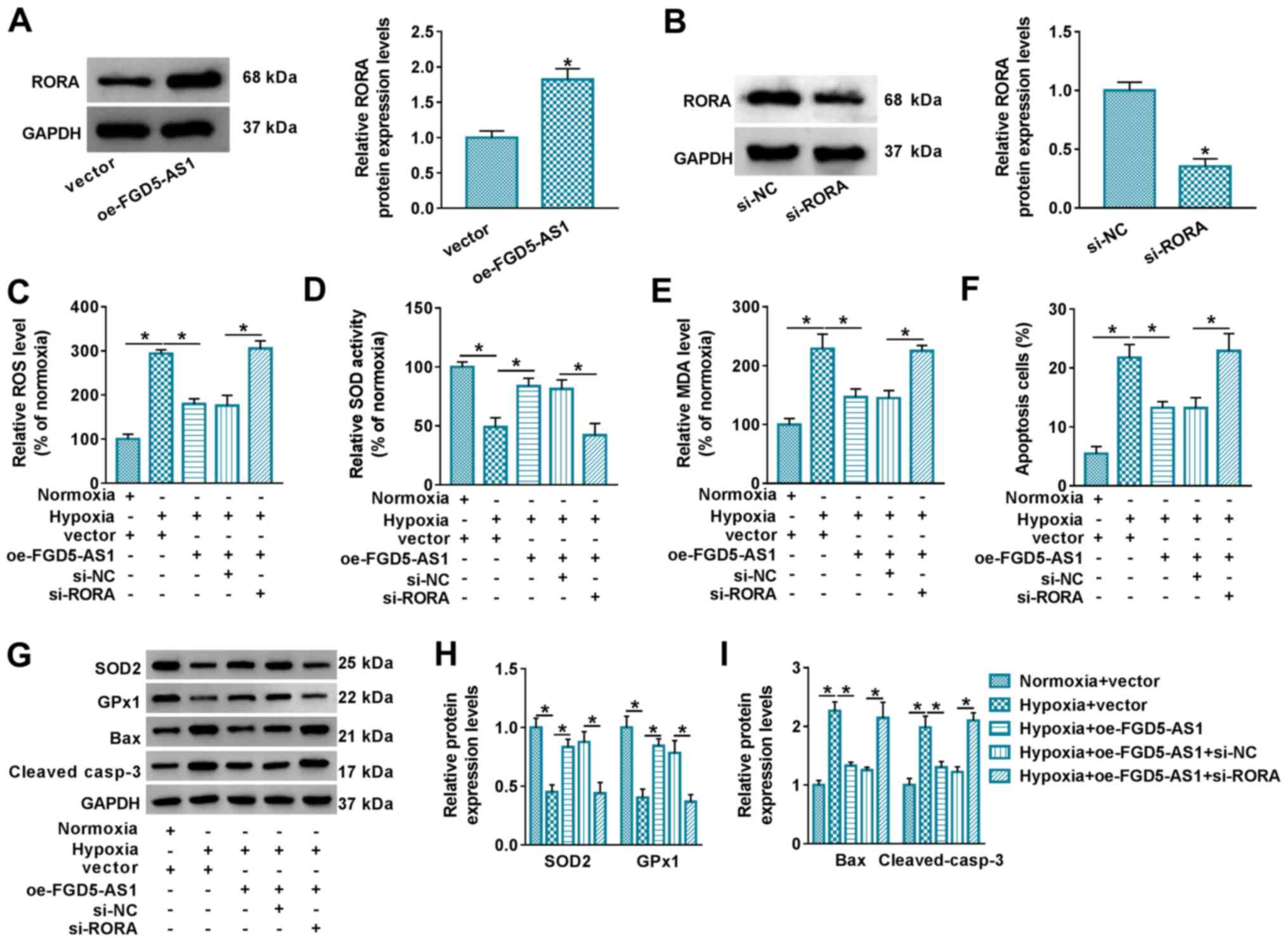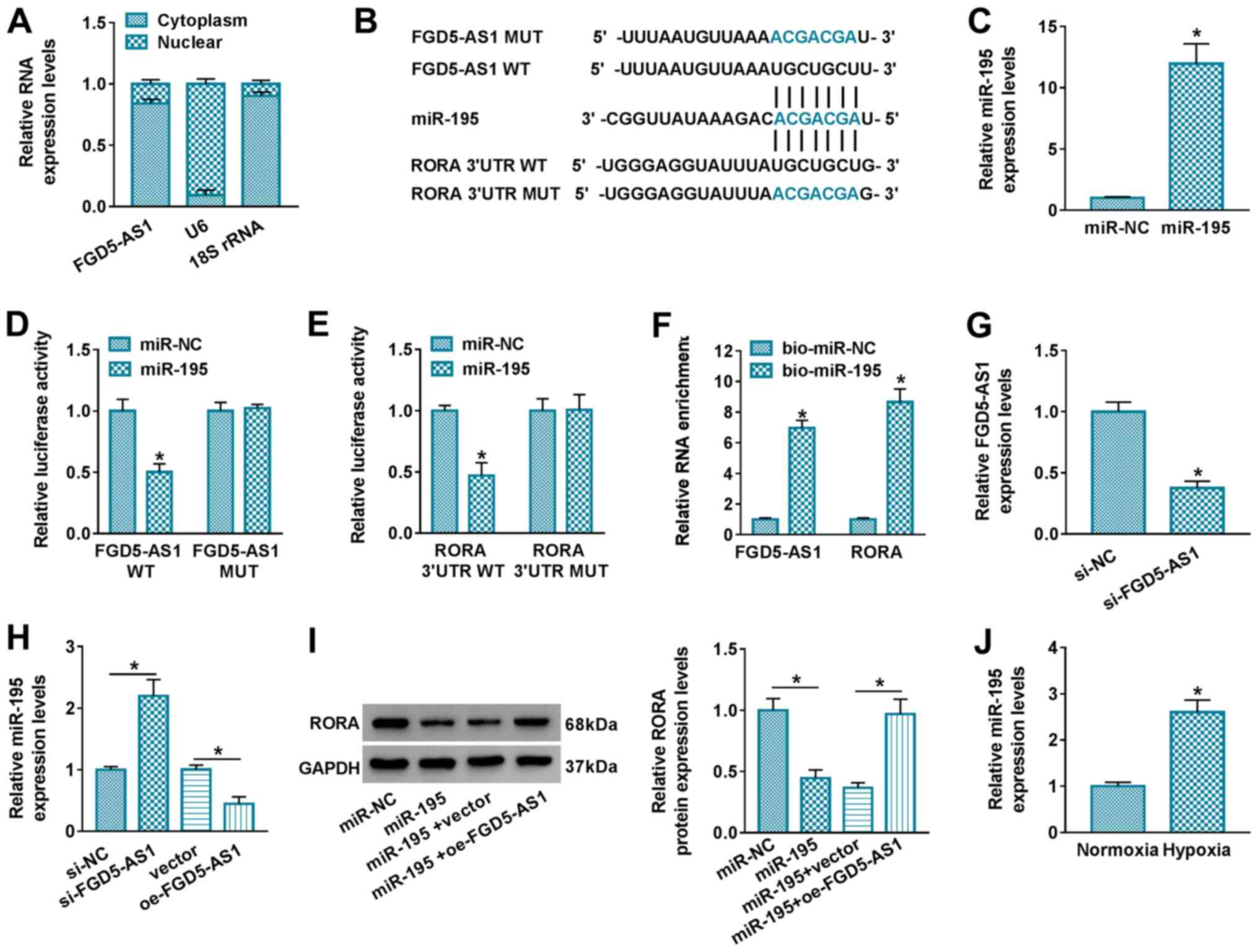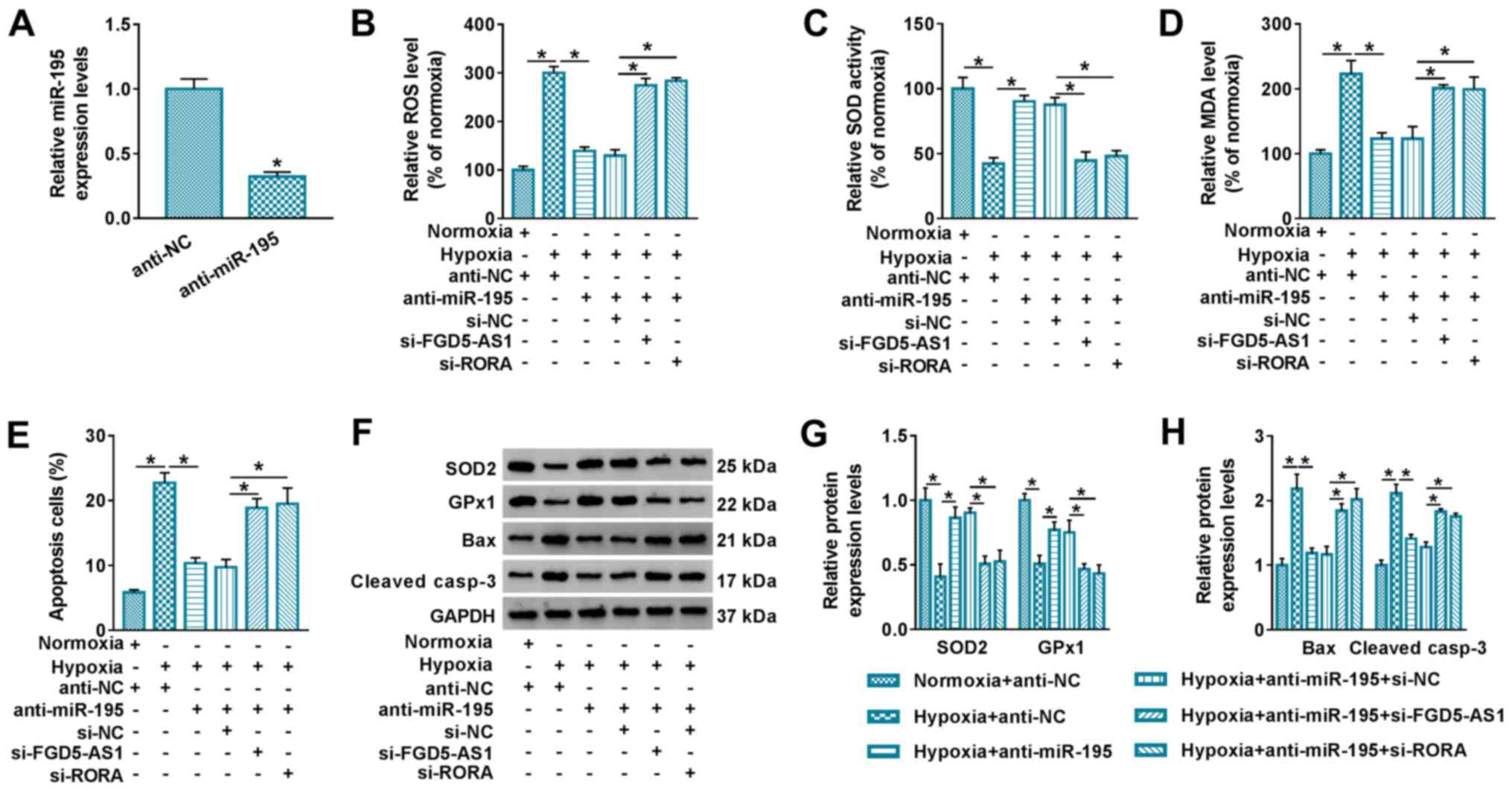|
1
|
GBD 2013 Mortality and Causes of Death
Collaborators: Global, regional, and national age-sex specific
all-cause and cause-specific mortality for 240 causes of death,
1990–2013: A systematic analysis for the global burden of disease
study 2013. Lancet. 385:117–171. 2015. View Article : Google Scholar : PubMed/NCBI
|
|
2
|
Lim GB: Acute coronary syndromes:
Supplemental oxygen in myocardial infarction. Nat Rev Cardiol.
14:6322017. View Article : Google Scholar
|
|
3
|
Ham PB III and Raju R: Mitochondrial
function in hypoxic ischemic injury and influence of aging. Prog
Neurobiol. 157:92–116. 2017. View Article : Google Scholar : PubMed/NCBI
|
|
4
|
Yu B, Meng F, Yang Y, Liu D and Shi K:
NOX2 antisense attenuates hypoxia-induced oxidative stress and
apoptosis in cardiomyocyte. Int J Med Sci. 13:646–652. 2016.
View Article : Google Scholar : PubMed/NCBI
|
|
5
|
Hou L, Guo J, Xu F, Weng X, Yue W and Ge
J: Cardiomyocyte dimethylarginine dimethylaminohydrolase1
attenuates left-ventricular remodeling after acute myocardial
infarction: Involvement in oxidative stress and apoptosis. Basic
Res Cardiol. 113:282018. View Article : Google Scholar : PubMed/NCBI
|
|
6
|
Zhang Y, Li C, Meng H, Guo D, Zhang Q, Lu
W, Wang Q, Wang Y and Tu P: BYD ameliorates oxidative
stress-induced myocardial apoptosis in heart failure post-acute
myocardial infarction via the P38 MAPK-CRYAB signaling pathway.
Front Physiol. 9:5052018. View Article : Google Scholar : PubMed/NCBI
|
|
7
|
Lucas T, Bonauer A and Dimmeler S: RNA
therapeutics in cardiovascular disease. Circ Res. 123:205–220.
2018. View Article : Google Scholar : PubMed/NCBI
|
|
8
|
Kaikkonen MU, Halonen P, Liu OH, Turunen
TA, Pajula J, Moreau P, Selvarajan I, Tuomainen T, Aavik E, Tavi P
and Ylä-Herttuala S: Genome-wide dynamics of nascent noncoding RNA
transcription in porcine heart after myocardial infarction. Circ
Cardiovasc Genet. 10:e0017022017. View Article : Google Scholar : PubMed/NCBI
|
|
9
|
Li H, Cheng Z, Tang Y, Feng M, Yin A,
Zhang H, Xu J, Zhang Q, Zhang J and Qian L: Expression profile of
long noncoding RNAs in cardiomyocytes exposed to acute ischemic
hypoxia. Mol Med Rep. 19:302–308. 2019.PubMed/NCBI
|
|
10
|
Ong SB, Katwadi K, Kwek XY, Ismail NI,
Chinda K, Ong SG and Hausenloy DJ: Non-coding RNAs as therapeutic
targets for preventing myocardial ischemia-reperfusion injury.
Expert Opin Ther Targets. 22:247–261. 2018. View Article : Google Scholar : PubMed/NCBI
|
|
11
|
Shen LS, Hu XF, Chen T, Shen GL and Cheng
D: Integrated network analysis to explore the key mRNAs and lncRNAs
in acute myocardial infarction. Math Biosci Eng. 16:6426–6437.
2019. View Article : Google Scholar : PubMed/NCBI
|
|
12
|
Liu H, Xu D, Zhong X, Xu D, Chen G, Ge J
and Li H: LncRNA-mRNA competing endogenous RNA network depicts
transcriptional regulation in ischaemia reperfusion injury. J Cell
Mol Med. 23:2272–2276. 2019. View Article : Google Scholar : PubMed/NCBI
|
|
13
|
Li D, Jiang X, Zhang X, Cao G, Wang D and
Chen Z: Long noncoding RNA FGD5-AS1 promotes colorectal cancer cell
proliferation, migration, and invasion through upregulating CDCA7
via sponging miR-302e. In Vitro Cell Dev Biol Anim. 55:577–585.
2019. View Article : Google Scholar : PubMed/NCBI
|
|
14
|
Lei Y, Shi Y, Duan J, Liu Y, Lv G, Shi R,
Zhang F, Yang Q and Zhao W: Identification of alternative splicing
and lncRNA genes in pathogenesis of small cell lung cancer based on
their RNA sequencing. Adv Clin Exp Med. 28:1043–1050. 2019.
View Article : Google Scholar : PubMed/NCBI
|
|
15
|
Zhu H, Lu J, Zhao H, Chen Z, Cui Q, Lin Z,
Wang X, Wang J, Dong H, Wang S and Tan J: Functional long noncoding
RNAs (lncRNAs) in clear cell kidney carcinoma revealed by
reconstruction and comprehensive analysis of the lncRNA-miRNA-mRNA
regulatory network. Med Sci Monit. 24:8250–8263. 2018. View Article : Google Scholar : PubMed/NCBI
|
|
16
|
Yu W, Liang X, Li X, Zhang Y, Sun Z, Liu Y
and Wang J: MicroRNA-195: A review of its role in cancers. Onco
Targets Ther. 11:7109–7123. 2018. View Article : Google Scholar : PubMed/NCBI
|
|
17
|
Katoh M: Cardio-miRNAs and onco-miRNAs:
Circulating miRNA-based diagnostics for non-cancerous and cancerous
diseases. Front Cell Dev Biol. 2:612014. View Article : Google Scholar : PubMed/NCBI
|
|
18
|
van Rooij E, Sutherland LB, Liu N,
Williams AH, McAnally J, Gerard RD, Richardson JA and Olson EN: A
signature pattern of stress-responsive microRNAs that can evoke
cardiac hypertrophy and heart failure. Proc Natl Acad Sci USA.
103:18255–18260. 2006. View Article : Google Scholar : PubMed/NCBI
|
|
19
|
Beak JY, Kang HS, Huang W, Myers PH,
Bowles DE, Jetten AM and Jensen BC: The nuclear receptor RORα
protects against angiotensin II-induced cardiac hypertrophy and
heart failure. Am J Physiol Heart Circ Physiol. 316:H186–H200.
2019. View Article : Google Scholar : PubMed/NCBI
|
|
20
|
He B, Zhao Y, Xu L, Gao L, Su Y, Lin N and
Pu J: The nuclear melatonin receptor RORα is a novel endogenous
defender against myocardial ischemia/reperfusion injury. J Pineal
Res. 60:313–326. 2016. View Article : Google Scholar : PubMed/NCBI
|
|
21
|
Livak KJ and Schmittgen TD: Analysis of
relative gene expression data using real-time quantitative PCR and
the 2(-Delta Delta C(T)) method. Methods. 25:402–408. 2001.
View Article : Google Scholar : PubMed/NCBI
|
|
22
|
Bar-Or D, Bar-Or R, Rael LT and Brody EN:
Oxidative stress in severe acute illness. Redox Biol. 4:340–345.
2015. View Article : Google Scholar : PubMed/NCBI
|
|
23
|
Wei Q, Zhou HY, Shi XD, Cao HY and Qin L:
Long noncoding RNA NEAT1 promotes myocardiocyte apoptosis and
suppresses proliferation through regulation of miR-129-5p. J
Cardiovasc Pharmacol. 74:535–541. 2019. View Article : Google Scholar : PubMed/NCBI
|
|
24
|
Hu H, Wu J, Yu X, Zhou J, Yu H and Ma L:
Long non-coding RNA MALAT1 enhances the apoptosis of cardiomyocytes
through autophagy inhibition by regulating TSC2-mTOR signaling.
Biol Res. 52:582019. View Article : Google Scholar : PubMed/NCBI
|
|
25
|
Lu W, Zhu L, Ruan ZB, Wang MX, Ren Y and
Li W: HOTAIR promotes inflammatory response after acute myocardium
infarction by upregulating RAGE. Eur Rev Med Pharmacol Sci.
22:7423–7430. 2018.PubMed/NCBI
|
|
26
|
Su Q, Liu Y, Lv XW, Dai RX, Yang XH and
Kong BH: LncRNA TUG1 mediates ischemic myocardial injury by
targeting miR-132-3p/HDAC3 axis. Am J Physiol Heart Circ Physiol.
318:H332–H344. 2020. View Article : Google Scholar : PubMed/NCBI
|
|
27
|
Jiao L, Li M, Shao Y, Zhang Y, Gong M,
Yang X, Wang Y, Tan Z, Sun L, Xuan L, et al: lncRNA-ZFAS1 induces
mitochondria-mediated apoptosis by causing cytosolic
Ca2+ overload in myocardial infarction mice model. Cell
Death Dis. 10:9422019. View Article : Google Scholar : PubMed/NCBI
|
|
28
|
Chen H, Lan Z, Li Q and Li Y: Abnormal
expression of long noncoding RNA FGD5-AS1 affects the development
of periodontitis through regulating miR-142-3p/SOCS6/NF-κB pathway.
Artif Cells Nanomed Biotechnol. 47:2098–2106. 2019. View Article : Google Scholar : PubMed/NCBI
|
|
29
|
Cheng WP, Lo HM, Wang BW, Chua SK, Lu MJ
and Shyu KG: Atorvastatin alleviates cardiomyocyte apoptosis by
suppressing TRB3 induced by acute myocardial infarction and
hypoxia. J Formos Med Assoc. 116:388–397. 2017. View Article : Google Scholar : PubMed/NCBI
|
|
30
|
Li S, Liu X, Li H, Pan H, Acharya A, Deng
Y, Yu Y, Haak R, Schmidt J, Schmalz G and Ziebolz D: Integrated
analysis of long noncoding RNA-associated competing endogenous RNA
network in periodontitis. J Periodontal Res. 53:495–505. 2018.
View Article : Google Scholar : PubMed/NCBI
|
|
31
|
He JF, Luo YM, Wan XH and Jiang D:
Biogenesis of MiRNA-195 and its role in biogenesis, the cell cycle,
and apoptosis. J Biochem Mol Toxicol. 25:404–408. 2011. View Article : Google Scholar : PubMed/NCBI
|
|
32
|
Hang P, Sun C, Guo J, Zhao J and Du Z:
BDNF-mediates Down-regulation of MicroRNA-195 inhibits ischemic
cardiac apoptosis in rats. Int J Biol Sci. 12:979–989. 2016.
View Article : Google Scholar : PubMed/NCBI
|
|
33
|
Zhang N, Meng X, Mei L, Hu J, Zhao C and
Chen W: The long non-coding RNA SNHG1 attenuates cell apoptosis by
regulating miR-195 and BCL2-like protein 2 in human cardiomyocytes.
Cell Physiol Biochem. 50:1029–1040. 2018. View Article : Google Scholar : PubMed/NCBI
|
|
34
|
Gao CK, Liu H, Cui CJ, Liang ZG, Yao H and
Tian Y: Roles of MicroRNA-195 in cardiomyocyte apoptosis induced by
myocardial ischemia-reperfusion injury. J Genet. 95:99–108. 2016.
View Article : Google Scholar : PubMed/NCBI
|
|
35
|
You XY, Huang JH, Liu B, Liu SJ, Zhong Y
and Liu SM: HMGA1 is a new target of miR-195 involving
isoprenaline-induced cardiomyocyte hypertrophy. Biochemistry
(Mosc). 79:538–544. 2014. View Article : Google Scholar : PubMed/NCBI
|
|
36
|
Wang L, Qin D, Shi H, Zhang Y, Li H and
Han Q: MiR-195-5p promotes cardiomyocyte hypertrophy by targeting
MFN2 and FBXW7. Biomed Res Int. 2019:15809822019.PubMed/NCBI
|
|
37
|
Zheng D, Ma J, Yu Y, Li M, Ni R, Wang G,
Chen R, Li J, Fan GC, Lacefield JC and Peng T: Silencing of miR-195
reduces diabetic cardiomyopathy in C57BL/6 mice. Diabetologia.
58:1949–1958. 2015. View Article : Google Scholar : PubMed/NCBI
|
|
38
|
Zhu H, Yang Y, Wang Y, Li J, Schiller PW
and Peng T: MicroRNA-195 promotes palmitate-induced apoptosis in
cardiomyocytes by down-regulating Sirt1. Cardiovasc Res. 92:75–84.
2011. View Article : Google Scholar : PubMed/NCBI
|
|
39
|
Zhang R, Garrett Q, Zhou H, Wu X, Mao Y,
Cui X, Xie B, Liu Z, Cui D, Jiang L, et al: Upregulation of miR-195
accelerates oxidative stress-induced retinal endothelial cell
injury by targeting mitofusin 2 in diabetic rats. Mol Cell
Endocrinol. 452:33–43. 2017. View Article : Google Scholar : PubMed/NCBI
|
|
40
|
Liu P, Peng QH, Tong P and Li WJ:
Astragalus polysaccharides suppresses high glucose-induced
metabolic memory in retinal pigment epithelial cells through
inhibiting mitochondrial dysfunction-induced apoptosis by
regulating miR-195. Mol Med. 25:212019. View Article : Google Scholar : PubMed/NCBI
|
|
41
|
Zhao Q, Wu K, Li N, Li Z and Jin F:
Identification of potentially relevant genes for myocardial
infarction using RNA sequencing data analysis. Exp Ther Med.
15:1456–1464. 2018.PubMed/NCBI
|
|
42
|
Zhao YC, Xu LW, Ding S, Ji QQ, Lin N, He
Q, Gao LC, Su YY, Pu J and He B: Nuclear receptor retinoid-related
orphan receptor alpha deficiency exacerbates high-fat diet-induced
cardiac dysfunction despite improving metabolic abnormality.
Biochim Biophys Acta Mol Basis Dis. 1863:1991–2000. 2017.
View Article : Google Scholar : PubMed/NCBI
|
|
43
|
Boukhtouche F, Vodjdani G, Jarvis CI,
Bakouche J, Staels B, Mallet J, Mariani J, Lemaigre-Dubreuil Y and
Brugg B: Human retinoic acid receptor-related orphan receptor
alpha1 overexpression protects neurones against oxidative
stress-induced apoptosis. J Neurochem. 96:1778–1789. 2006.
View Article : Google Scholar : PubMed/NCBI
|
|
44
|
Han YH, Kim HJ, Kim EJ, Kim KS, Hong S,
Park HG and Lee MO: RORα decreases oxidative stress through the
induction of SOD2 and GPx1 expression and thereby protects against
nonalcoholic steatohepatitis in mice. Antioxid Redox Signal.
21:2083–2094. 2014. View Article : Google Scholar : PubMed/NCBI
|
|
45
|
Xin M, Jin X, Cui X, Jin C, Piao L, Wan Y,
Xu S, Zhang S, Yue X, Wang H, et al: Dipeptidyl peptidase-4
inhibition prevents vascular aging in mice under chronic stress:
Modulation of oxidative stress and inflammation. Chem Biol
Interact. 314:1088422019. View Article : Google Scholar : PubMed/NCBI
|
|
46
|
Chang CJ, Hsu HC, Ho WJ, Chang GJ, Pang
JS, Chen WJ, Huang CC and Lai YJ: Cathepsin S promotes the
development of pulmonary arterial hypertension. Am J Physiol Lung
Cell Mol Physiol. 317:L1–L13. 2019. View Article : Google Scholar : PubMed/NCBI
|
|
47
|
Hu L, Huang Z, Ishii H, Wu H, Suzuki S,
Inoue A, Kim W, Jiang H, Li X, Zhu E, et al: PLF-1 (Proliferin-1)
modulates smooth muscle cell proliferation and development of
experimental intimal hyperplasia. J Am Heart Assoc. 8:e0058862019.
View Article : Google Scholar : PubMed/NCBI
|
|
48
|
Hua Y, Zhang Y, Dolence J, Shi GP, Ren J
and Nair S: Cathepsin K knockout mitigates high-fat diet-induced
cardiac hypertrophy and contractile dysfunction. Diabetes.
62:498–509. 2013. View Article : Google Scholar : PubMed/NCBI
|
|
49
|
Yang YY, Li LY, Jiao XL, Jia LX, Zhang XP,
Wang YL, Yang S, Li J, Du J, Wei YX and Qin YW: Intermittent
hypoxia alleviates β-aminopropionitrile monofumarate induced
thoracic aortic dissection in C57BL/6 mice. Eur J Vasc Endovasc
Surg. 59:1000–1010. 2020. View Article : Google Scholar : PubMed/NCBI
|
|
50
|
Jiang H, Cheng XW, Shi GP, Hu L, Inoue A,
Yamamura Y, Wu H, Takeshita K, Li X, Huang Z, et al: Cathepsin
K-mediated Notch1 activation contributes to neovascularization in
response to hypoxia. Nat Commun. 5:38382014. View Article : Google Scholar : PubMed/NCBI
|
|
51
|
Li CC, Qiu XT, Sun Q, Zhou JP, Yang HJ, Wu
WZ, He LF, Tang CE, Zhang GG and Bai YP: Endogenous reduction of
miR-185 accelerates cardiac function recovery in mice following
myocardial infarction via targeting of cathepsin K. J Cell Mol Med.
23:1164–1173. 2019. View Article : Google Scholar : PubMed/NCBI
|
|
52
|
Zeng Z, Yao J, Li Y, Xue Y, Zou Y, Shu Z
and Jiao Z: Anti-apoptosis endothelial cell-secreted
microRNA-195-5p promotes pulmonary arterial smooth muscle cell
proliferation and migration in pulmonary arterial hypertension. J
Cell Biochem. 119:2144–2155. 2018. View Article : Google Scholar : PubMed/NCBI
|
|
53
|
Gu J, Zhang H, Ji B, Jiang H, Zhao T,
Jiang R, Zhang Z, Tan S, Ahmed A and Gu Y: Vesicle miR-195 derived
from endothelial cells inhibits expression of serotonin transporter
in vessel smooth muscle cells. Sci Rep. 7:435462017. View Article : Google Scholar : PubMed/NCBI
|
|
54
|
Gulec C, Coban N, Ozsait-Selcuk B,
Sirma-Ekmekci S, Yildirim O and Erginel-Unaltuna N: Identification
of potential target genes of ROR-alpha in THP1 and HUVEC cell
lines. Exp Cell Res. 353:6–15. 2017. View Article : Google Scholar : PubMed/NCBI
|
|
55
|
Kim SY, Kim HJ, Park MK, Huh JW, Park HY,
Ha SY, Shin JH and Lee YS: Mitochondrial E3 ubiquitin protein
ligase 1 mediates cigarette smoke-induced endothelial cell death
and dysfunction. Am J Respir Cell Mol Biol. 54:284–296. 2016.
View Article : Google Scholar : PubMed/NCBI
|
|
56
|
Besnard S, Heymes C, Merval R, Rodriguez
M, Galizzi JP, Boutin JA, Mariani J and Tedgui A: Expression and
regulation of the nuclear receptor RORalpha in human vascular
cells. FEBS Lett. 511:36–40. 2002. View Article : Google Scholar : PubMed/NCBI
|
|
57
|
Xu L, Su Y, Zhao Y, Sheng X, Tong R, Ying
X, Gao L, Ji Q, Gao Y, Yan Y, et al: Melatonin differentially
regulates pathological and physiological cardiac hypertrophy:
Crucial role of circadian nuclear receptor RORα signaling. J Pineal
Res. 67:e125792019. View Article : Google Scholar : PubMed/NCBI
|
|
58
|
Porrello ER, Johnson BA, Aurora AB,
Simpson E, Nam YJ, Matkovich SJ, Dorn GW II, van Rooij E and Olson
EN: MiR-15 family regulates postnatal mitotic arrest of
cardiomyocytes. Circ Res. 109:670–679. 2011. View Article : Google Scholar : PubMed/NCBI
|















